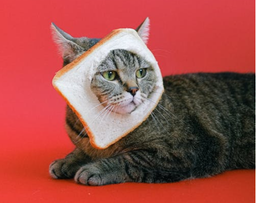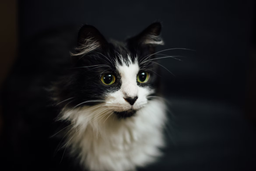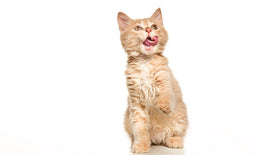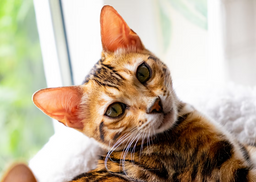How to find the best food for Ragdoll cats in the UK
Ragdolls are gentle giants adored for their laid-back personality and amiable disposition. When looking for the best food for Ragdoll cats in the UK, you should opt for products suitable for their laid-back lifestyle.
Ragdolls are prone to obesity, but their weight fluctuations often go unnoticed because they are naturally large and fluffy. The cat food you get should meet your feline's daily energy requirements, contain enough animal protein, and be free of potential allergens and unnecessary fillers (e.g., grains, vegetables, and animal derivatives).
We will explain what should or shouldn’t go in a Ragdoll’s diet and introduce you to Untamed wet food that fulfils the dietary needs of this happy-go-lucky breed.
Ragdoll cat food—how many calories should it offer?
Unlike athletic breeds, such as Bengals and Siamese, Ragdolls have a relatively sedentary lifestyle. Even though they are mostly inactive indoor cats, Ragdolls need considerable energy to sustain their large build. As a general rule, vets recommend feeding Ragdolls 40–45 calories per day for every kilo of their body weight. Here’s the ideal weight range for this breed:
|
Gender |
Weight range (in kilograms) |
|
Male Ragdolls |
5.4–9.1 |
|
Female Ragdolls |
3.6–6.8 |
The daily caloric needs of Ragdolls (neutered or otherwise) sit between 200 and 400 calories, but it’s important to ensure the energy comes from the right sources.
Cats can burn proteins, carbohydrates, and fats for energy, but carbs are an inferior source because they're not fully compatible with the feline digestive system.

I don’t do gardens, human. Too. Much. Soil. How about we go back to that comfy couch and have a snack?
Source: swiatowskaagata
The best Ragdoll cat food must have animal proteins
Proteins are essential nutrients for all felines, including Ragdolls because they participate in:
- Regeneration and maintenance of bones, tendons, cartilage, and ligaments
- Muscle development and upkeep
- Proper functioning of the nervous system
- Skin and coat health (preventing hairballs)
- Adequate immune responses
The quality and quantity of proteins in meals directly impact your Ragdoll’s health.
How much protein should be in Ragdoll cat food?
Proteins should be the primary source of energy for Ragdolls. Feline nutritionists recommend giving this breed high-protein cat food, so you should choose products with up to 50% animal protein. Each gram of protein has four calories, so a diet rich in this micronutrient helps lethargy-prone Ragdolls stay energetic throughout the day.
If your cat tends to overeat, protein-dominant meals can help keep hunger under control by making them feel full longer. Products with low protein content can trigger excessive shedding, even causing malnourishment in extreme cases.
What are the ideal protein sources for Ragdolls?
Protein in cat food must come from quality meat—not only for Ragdolls but for all cats. The feline digestive system is designed to take essential amino acids—like taurine and arginine—from whole meats and organs. When it comes to proteins, many products fail to deliver because they use:
- Animal derivatives—Meat and animal derivatives are cheap slaughterhouse scraps deemed unfit for human consumption (hooves, chicken feet, guts, and lungs). They are processed and added to cat food to buff up the “meat” percentage. Manufacturers that use vague terms like “Meat & Animal Derivatives” or “Meat Meals” on the labels usually produce substandard food
- Vegetable proteins—There’s nothing noble about giving plant-based proteins to hardwired carnivores like cats because the amino acid profile is inadequate. Felines dependent on meat-free proteins develop a taurine deficiency, potentially leading to renal dysfunction, cardiomyopathy, and retinal damage
- Synthetic proteins—Many manufacturers use lab-synthesised proteins to reach the minimum nutrition values recommended by UK’s Pet Food Manufacturers’ Association (PFMA), but the digestibility and bioavailability of such proteins remain questionable
Whether preparing a homemade meal or buying cat food, always ensure your Ragdoll gets their proteins from whole meat.

Cool, I’ll pose with these green things as long as you don’t make me eat ’em. Oh, the things we do for our beloved two-leggers!
Source: swiatowskaagata
How much protein do Ragdolls need?
Adult Ragdolls need about five to six grams of proteins per kilo of their weight, although pregnant or nursing cats may need more. Check out the protein values in common meat sources in the following table:
|
Source |
Portion size |
Protein value |
|
Beef |
100 grams |
26 grams |
|
100 grams |
27 grams |
|
|
Turkey |
100 grams |
27 grams |
|
Pork |
100 grams |
27 grams |
|
Tuna |
100 grams |
26 grams |
|
Salmon |
100 grams |
20 grams |
|
Mackerel |
100 grams |
19 grams |
|
Crustacean |
100 grams |
19 grams |
|
Imitation crab meat |
1 stick |
8 grams |
Tread carefully when feeding fats to Ragdolls
Ragdolls need a minimal amount of fats in their diet to support various processes like:
- Absorbing vitamins and minerals
- Regulating body temperature
- Maintaining hormonal balance
- Releasing energy (a gram of metabolised fat equals nine calories)
Even though animal fat is healthy for Ragdolls, you should be careful with the amount. These super cute giants gain weight quickly, so low-fat food is a better option. You should also avoid giving them too many fatty treats like eggs, crisps, fish fats, milk, and other dairy products like cheese.
Feeding carbohydrates to Ragdolls is not a good idea
A cat’s natural diet consists of raw meat from fresh prey, meaning almost no carbs in their meals. Unfortunately, carbohydrates have become a popular filler in the pet food industry. Grains, sugar, rice, or potato starch are useless to cats, and they don't add nutritional value to cat food.
Carbs create a calorie surplus which can lead to obesity, diabetes, and heart disease. Considering a Ragdoll’s general inactivity, vets recommend keeping carbohydrates strictly under three per cent in their diet.
Cats also struggle to digest carbs and develop carbohydrate intolerance, leading to various gastrointestinal issues like:
- Bloating
- Constipation
- Stomach sensitivity
- Diarrhoea
- Vomiting
- Cramps
What vitamins and minerals do Ragdolls need?
Besides proteins and fats, Ragdolls need specific vitamins and minerals in their diet for electrolyte balance, proper organ function, and bone and dental health. Check out the table below for more details:
|
Vitamins |
Minerals |
|
● Vitamin A ● Vitamin D ● Vitamin E ● Vitamin K ● Thiamin ● Pyridoxine ● Folic Acid ● Vitamin B12 ● Choline ● Biotin ● Riboflavin ● Pantothenic acid ● Niacin |
● Calcium ● Phosphorus ● Zinc ● Iodine ● Selenium ● Potassium ● Iron ● Copper ● Manganese ● Sodium and chloride ● Magnesium |
Ragdolls get most of these vitamins and minerals from meat, but commercial cat food manufacturers may add them synthetically in case there's not enough meat in their products.
Is your Ragdoll getting the hydration they need?
Ragdolls need 50–60 millilitres of water daily per kilogram of their weight to avoid dehydration-related conditions like bladder stones, IBS (Irritable Bowel Syndrome), and cystitis.
Whether your cat is on a dry or wet food diet also affects the necessary water intake.
If your cat refuses to drink water, try making them an iced tea instead:
Source: Chef Cat ChangAn
Dry food for Ragdolls
Cat parents like dry food because it is affordable and convenient to store, but most vets don’t recommend a kitty biscuit diet for Ragdolls. On average, dry cat food has more carbs and less protein than wet food. Aggressive processing methods destroy the nutrients and reduce the moisture content to ten per cent. If you are feeding dry food to your Ragdoll, ensure they get the hydration they need by:
- Adding complementary wet food to their diet, either as a topping or a side dish
- Softening cat kibble with meat-based soups, broths, or sodium-free stock to get a semi-moist consistency
- Cleaning and refilling their bowl with fresh water every day
- Installing multiple water stations around the house
Wet food for Ragdolls
Ragdolls on a complete wet food diet don’t have trouble staying hydrated. Wet food usually contains about 70–80% moisture, meaning it offers about 110–130 millilitres of water per serving. While wet food is an easy way to prevent dehydration, it can also be filled with useless or incompatible ingredients. Opt for grain-free products with whole meat and no artificial additives. If the manufacturer did not state the carb percentage, you can calculate it yourself:
- Add the moisture, crude protein, and crude fat percentages of the product
- Subtract the value from 100
The resulting figure would be the rough percentage of carbs and fillers in the product. Avoid cat food with more than three per cent of carbs.

Finally! This is what I call “my territory”. Now, where’s that snack we talked about?
Source: swiatowskaagata
What’s the best food for a Ragdoll kitten?
Ragdoll kittens grow at a steady pace for the first year of their life. Some even keep developing till they are three! To avoid stunted growth, you should give them kitten food with the best cuts of whole meat rich in proteins, vitamins, and minerals.
Give Ragdoll kittens hypoallergenic wet food when they start eating solids. That way, you can lower the risk of an allergic reaction or a tummy upset. Avoid using dry food in your Ragdoll kitten’s diet because they can get hooked and reject wet food later on.
You should feed your Ragdoll kitten three to five times during the first six months of their life. After that, you can cut down to two or three meals a day, depending on their weight. Many cat parents ignore recommended portions and free-feed their Ragdolls throughout kittenhood. That’s not a good idea because it can lead to eating disorders.

When cat food hunting gets confusing, try Untamed wet food products—it’s the best around town!
Image (c) Untamed
Untamed is the best cat food for Ragdolls—here’s why!
Trying different types of cat food is tiresome for cat parents and confusing to felines. Some products may provoke a fussy diva tantrum in your Ragdoll, while those they approve of are usually full of unhealthy fats and flavour enhancers.
If you want healthy and tasty food, switch to Untamed! Our jelly and gravy delicacies are made from prime cuts of human-grade whole meat, organs, and fish to ensure your cat gets only the best. We use meat from cruelty-free sources, which also guarantee no contaminants and harmful additives.
Our products are perfect for Ragdolls because they:
- Have a high protein content—Untamed stands out because we are all about real animal proteins. Our products are free from iffy fillers like grains, sugars, animal derivatives, and vegan proteins. Our complete gravy and jelly recipes are made with 60–63% of whole meats, offering twice the amount of protein than the industry average
- Are delicious—Our food smells and tastes amazing because we use fresh and high-quality ingredients. To cater to Ragdolls’ refined taste, we offer a variety of meals with chicken, duck, tuna, salmon, mackerel, sardine, ham, and shrimp
- Are gently cooked—We gently steam our recipes to prevent nutrition depletion. This cooking method also keeps the natural aroma intact, so even finicky eaters won’t resist Untamed
Our products come in tins that can be stored and served easily. You don’t have to freeze, defrost, or heat our food before serving. Plate it, and your cat can dig right in!
Click here to take our TRY NOW quiz and order your Untamed taster pack at the best price!
Not only Ragdolls—Untamed is suitable for all cats
Our products are beneficial for cats of all breeds and ages. A whole-meat diet keeps your cuddly predator healthy and happy! Here’s how Untamed helps cats through different life stages:
- Kittenhood—Untamed’s high-protein meals benefit muscle building and brain-function development in kittens. We have two hypoallergenic products in our mix—Chocka Chicken in Gravy and Tuck-in Tuna in Gravy tailored for kittens (or adults) with food allergies
-
Adulthood—Our food contains necessary amino acids, vitamins, and minerals, for the sustenance of grown-up felines. Adulthood is when cats on an unhealthy diet start gaining weight. Feeding Untamed to your kitty will keep their urge to snack between meals under control—it’s the ultimate diet cat food! Untamed’s well-portioned food not only does wonders with weight issues but also helps adults:
- Retain muscle tone
- Have glossy skin and coat
- Develop immunity against seasonal illnesses
- Enjoy consistent energy levels
- Golden years—With Untamed, senior cats can stay active and fit! Our food helps manage common age-related illnesses like anorexia, arthritis, and diabetes. If your older cat is not eating due to loss of teeth, Untamed’s delicious soft morsels will be easy to chew and swallow

Food cats hate to share—surprise your cat with a taster pack and watch them glow with joy!
Image (c) Untamed
Buying Untamed is as easy as pie—here’s how to order your first pack!
Are you ready to go Untamed? Follow these steps to order our healthy cat food online:
- Complete our TRY NOW quiz to tell us all about your cat
- Review the meal plan
- Place the order
The trial taster pack will be delivered to your doorstep within a day—all our deliveries are always free! If your kitty loves our meals, we will replenish your cat food supplies every month. You can modify, pause, skip, or cancel a delivery any time!
We believe in ethical cat food production and use recyclable packaging for all our products. Our operations leave a minimal carbon footprint.
All our products have a shelf life of three years, so they can sit in your pantry for a long time without going bad!
What about snacks?
It doesn’t matter if you’re dealing with Ragdolls, British Shorthairs, or Persian cats—all felines love meat. Here are some protein snacks you can give to your Ragdoll:
- Freeze-dried raw chicken or turkey
- Raw bones (cooked bones are a choking hazard)
- Shredded tuna
You can also give occasional fruits (bananas, apples, strawberries, watermelons, etc.) and cooked vegetables to your Ragdoll, but make sure to offer them in bite-sized pieces only. Keep in mind that meat is the only beneficial food for cats, so fruits and vegetables cannot replace it.
The following ingredients are dangerous for cats and shouldn't be on their menu:
- Grapes
- Green potatoes and tomatoes
- Wild mushrooms
- Artificial sweeteners like Xylitol
- Rhubarb leaves and stalks
- Allium veggies (onions, chives, etc.)
- Raw yeast
- Caffeine and alcohol
If your cat accidentally eats anything suspicious, keep a close eye on them for a day. Rush them to the nearest clinic if you notice any signs of food poisoning, like vomiting, lethargy, excessive drooling, food aversion, shivers, etc.

Still a kitty, but looks like I no longer fits. Thanks for feeding me nice, healthy nom-noms, hooman. But first, get me a new bed!
Source: hugothelynxragdoll
Ragdolls and hairballs—is there a solution?
Ragdolls have semi-long coats that require frequent grooming. While a bit of shedding is expected, there shouldn’t be too many hairballs. They are not a breed-specific problem but an indication of a protein-deficient diet. If you notice too many hairballs, switch to cat food with whole meat because it can usually fix the problem in one to three months.
If your Ragdoll retches but cannot throw up hairballs, it could be a sign of intestinal obstruction. Try giving them cat grass to encourage productive regurgitation or take them to the vet.



